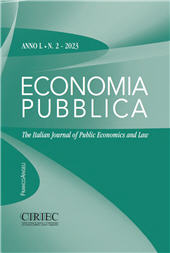La regola della metà per la misura dei benefici degli utenti ed il suo fondamento microeconomico
149-169 p.
La misura dei benefici degli utenti è un fondamentale ingrediente della valutazione economica di progetti e politiche nel settore dei trasporti. La regola della metà si è affermata nella pratica applicativa a livello internazionale. Tuttavia, la giustificazione intuitiva e il fondamento microeconomico non sono stati ancora declinati nella loro completezza. L'articolo è finalizzato a colmare questa lacuna. Per la giustificazione intuitiva, forniamo lo sviluppo matematico che conduce alla regola a partire dai valori medi del beneficio per la domanda che resta e per la domanda che si trasferisce. Per il fondamento teorico si danno due casi.
Quello della teoria classica della domanda, e quello delle scelte discrete con utilità aleatoria. Per entrambi, la letteratura deriva la regola della metà come approssimazione dell'integrale di linea del surplus. Per il primo caso, formuliamo un modello di comportamento del consumatore con numerario e preferenze quasi-lineari con utilità quadratica che consentono di esprimere la domanda e l'utilità indiretta in funzione dei costi generalizzati. Dimostriamo che la regola fornisce il valore approssimato del surplus Marshalliano, della variazione compensativa e della variazione equivalente del consumatore rappresentativo. Per il secondo caso, consideriamo un modello con reddito ininfluente sulle scelte e termini aleatori additivi. Dimostriamo che la regola fornisce la misura approssimata del valore atteso della variazione compensativa e della variazione equivalente [Testo dell'editore].
The measurement of users' benefits is a key ingredient of the economic evaluation of projects and policies. The rule-of-a-half (RoH) is part of the consolidated prac-tice at international level. However, its intuitive justification and microeconomic foundation have not been cast in full. The paper aims to fill this gap. As to the intuitive justification, we provide the mathematical developments that yield the RoH starting from the average values of the benefits for the non-shifting and shift- ing demand. As to the theoretical foundation, we consider two cases. The one of classical demand theory, and the one of discrete choices with random utility. For both, literature obtains the RoH as an approximation of the surplus line integral.
As to the first, we formulate a consumer's behaviour model with numéraire and quasi-linear preferences with quadratic utility that allow demand and indirect util- ity to be expressed as function of generalised costs. We prove that the RoH provides the approximate value of the Marshallian surplus, compensating variation and equivalent variation of the representative consumer. As to the second, we con- sider a model without income effect and additive random terms. We prove that the RoH provides the approximate value of the expectations of the compensating var- iation and equivalent variation. [Publisher's text].
Is part of
Economia pubblica : L, 2, 2023-
Articles from the same issue (available individually)
-
-
Information
ISSN: 1972-5566
KEYWORDS
- regola della metà, scelta discreta, utilità aleatoria, variazione com- pensativa, variazione equivalente
- compensating variation, discrete choice, equivalent variation, random utility, rule-of-a-half


